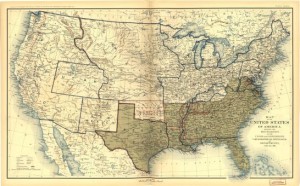 Baptist churches South and North navigate the war years in a variety of ways. Many Baptist churches of the Confederacy are forced to close their doors due to the loss of so many members to the army, lack of pastoral leadership, economic pressures, proximity to army activity, confiscation by the Union Army, or a combination of several of these factors. In some respects, the uncertainty of congregational Baptist life is more intense in the border states than other areas. And despite general patterns indicative of many churches’ responses to the war, some congregations stand apart from most of their sister churches.
Baptist churches South and North navigate the war years in a variety of ways. Many Baptist churches of the Confederacy are forced to close their doors due to the loss of so many members to the army, lack of pastoral leadership, economic pressures, proximity to army activity, confiscation by the Union Army, or a combination of several of these factors. In some respects, the uncertainty of congregational Baptist life is more intense in the border states than other areas. And despite general patterns indicative of many churches’ responses to the war, some congregations stand apart from most of their sister churches.
In an unusual twist, this month the Shady Grove General Baptist Church of Poole, Kentucky, having met only sporadically since the previous year due to the war, reopens its doors and returns to regular weekly services for the remainder of the war, although the fighting in Kentucky is far from over.
Meanwhile, across the Ohio River in Northern territory, the war makes itself felt within the Providence Baptist Church of Gallia County, Ohio, following the demise of a sister Baptist church.
In April 1863, A. J. Warren offered himself as a candidate for membership as the church to which he had belonged, Green Bottom had gone down on account of unholy Rebellion, and the church received him.
In short, as villages, towns and cities South and North are often disrupted by the war, so are Baptist communities of faith.
Sources: History of Shady Grove General Baptist Church (link); “History of Providence Baptist Church,” Gallia County, Ohio (link)


